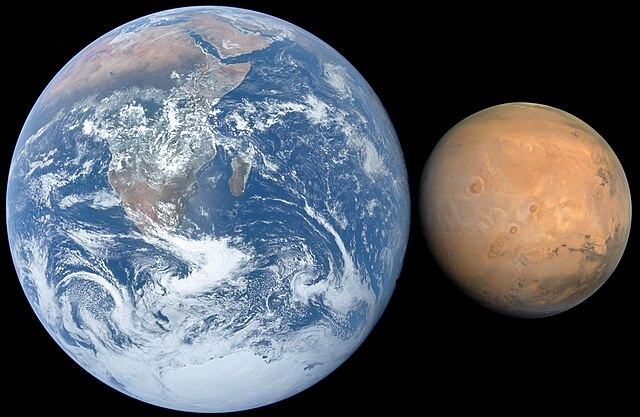The magnetic field of Mars is the magnetic field generated from Mars' interior. Today, Mars does not have a global magnetic field. However, Mars did power an early dynamo that produced a strong magnetic field 4 billion years ago, comparable to Earth's present surface field. After the early dynamo ceased, a weak late dynamo was reactivated ~3.8 billion years ago. The distribution of Martian crustal magnetism is similar to the Martian dichotomy. Whereas the Martian northern lowlands are largely unmagnetized, the southern hemisphere possesses strong remanent magnetization, showing alternating stripes. Scientific understanding of the evolution of the magnetic field of Mars is based on the combination of satellite measurements and Martian ground-based magnetic data.
Martian Dynamo. The schematic illustration of the ancient dipolar magnetic field of Mars generated by a core dynamo process.
Timeline of the Martian dynamo. Grey shading represents possible age constraints (in Ga years) for the early and late dynamo. Stars indicate new age constraints from MAVEN data. [a] Early dynamo before the formation of Hellas, Isidis, and Argyre. [b] The cessation of the early dynamo based on large basin population. [c] The age of ALH84001. [d] Late dynamo after the formation of the major basins.
Mars is the fourth planet from the Sun. The surface of Mars is orange-red because it is covered in iron(III) oxide dust, giving it the nickname "the Red Planet". Mars is among the brightest objects in Earth's sky, and its high-contrast albedo features have made it a common subject for telescope viewing. It is classified as a terrestrial planet and is the second smallest of the Solar System's planets with a diameter of 6,779 km (4,212 mi). In terms of orbital motion, a Martian solar day (sol) is equal to 24.5 hours, and a Martian solar year is equal to 1.88 Earth years. Mars has two natural satellites that are small and irregular in shape: Phobos and Deimos.
Comparison: Earth and Mars
Curiosity's view of Martian soil and boulders after crossing the "Dingo Gap" sand dune
Valles Marineris, taken by the Viking 1 probe
Edge-on view of Mars atmosphere by Viking 1 probe






